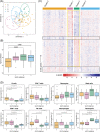RNA sequencing of peripheral blood in amyotrophic lateral sclerosis reveals distinct molecular subtypes: Considerations for biomarker discovery
- PMID: 37818590
- PMCID: PMC10946588
- DOI: 10.1111/nan.12943
RNA sequencing of peripheral blood in amyotrophic lateral sclerosis reveals distinct molecular subtypes: Considerations for biomarker discovery
Abstract
Aim: Amyotrophic lateral sclerosis (ALS) is a heterogeneous neurodegenerative disease with limited therapeutic options. A key factor limiting the development of effective therapeutics is the lack of disease biomarkers. We sought to assess whether biomarkers for diagnosis, prognosis or cohort stratification could be identified by RNA sequencing (RNA-seq) of ALS patient peripheral blood.
Methods: Whole blood RNA-seq data were generated for 96 Australian sporadic ALS (sALS) cases and 48 healthy controls (NCBI GEO accession GSE234297). Differences in sALS-control gene expression, transcript usage and predicted leukocyte proportions were assessed, with pathway analysis used to predict the activity state of biological processes. Weighted Gene Co-expression Network Analysis (WGCNA) and machine learning algorithms were applied to search for diagnostic and prognostic gene expression patterns. Unsupervised clustering analysis was employed to determine whether sALS patient subgroups could be detected.
Results: Two hundred and forty-five differentially expressed genes were identified in sALS patients relative to controls, with enrichment of immune, metabolic and stress-related pathways. sALS patients also demonstrated switches in transcript usage across a small set of genes. We established a classification model that distinguished sALS patients from controls with an accuracy of 78% (sensitivity: 79%, specificity: 75%) using the expression of 20 genes. Clustering analysis identified four patient subgroups with gene expression signatures and immune cell proportions reflective of distinct peripheral effects.
Conclusions: Our findings suggest that peripheral blood RNA-seq can identify diagnostic biomarkers and distinguish molecular subtypes of sALS patients however, its prognostic value requires further investigation.
Keywords: RNA-seq; amyotrophic lateral sclerosis; biomarker; ferroptosis; immune response; metabolism; peripheral blood; transcriptome.
© 2023 The Authors. Neuropathology and Applied Neurobiology published by John Wiley & Sons Ltd on behalf of British Neuropathological Society.
Conflict of interest statement
The authors declare no competing interests.
Figures





References
Publication types
MeSH terms
Substances
Grants and funding
LinkOut - more resources
Full Text Sources
Medical
Molecular Biology Databases
Miscellaneous

